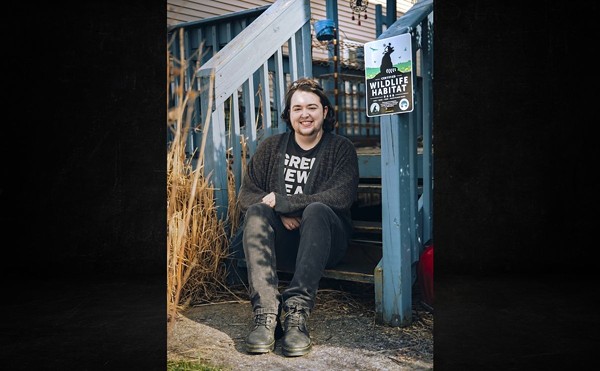During the installation of her new show I surrender, dear at downtown’s Contemporary Arts Center, Moscow-born/New York-based artist Dasha Shishkin and I discussed a range of issues, including the possibility that she might be a witch. It’s true that divining rods, transubstantiation and the Russian Orthodox Church aren’t your standard meet-and-greet/photo-op topics. But Shishkin is no ordinary artist.
Already a seasoned veteran of prestigious national and international exhibitions at age 34, Shishkin’s drawings appear in the permanent collections of several major museums and have been featured in a number of high profile publications. Celebrated for an audacious use of saturated color and an equally confident line, Shishkin’s subject matter embraces both the gorgeous and the grotesque.
The current show at the CAC features a career-spanning selection of works. Reaching as far back as 2001, more than 30 of Shishkin’s brash, hallucinatory drawings are clustered, salon style, into the northeast corner of the second floor gallery. Adjacent to the installation, 10 exquisite etchings occupy the narrow corridor off of the main gallery.
The layout is a bold gambit. By creating an overlapping installation of pictures that were conceived and executed as individual works, the viewer is compelled to seek a master narrative that doesn’t exist. Besides making the experience feel a little too clever for its own good, the visceral impact of singular pictures such as “If God is for Us Who Can Be Against Us” are diminished.
In that drawing’s pungent red interior, multicolored figures sporting lunch lady uniforms dine on a smorgasbord of carved human limbs and warm slivers of cake. Eating, smoking and unnecessary surgery are commonly depicted themes in Shishkin’s work, but coherent narratives remain elusive. While some viewers might recoil in horror at images of cannibalism or feces being transformed into sausage, beyond the schoolyard prurience lays a tremendous amount of humor and not a little beauty.
Shishkin’s pieces are frequently compared to the likes of Expressionist Egon Schiele, outsider Henry Darger and Dutch Renaissance master Pieter Bruegel. That’s no small praise, but Shishkin’s antecedents feel literary rather than visual. The artist’s fondness for language is particularly evident in the choice of titles. Appellations such as “Hideous potato, missed terribly, with likes and no hate” and “What Is There That Forgiveness Cannot Achieve” range from being merely amusing to haltingly poetic.
The phallic-nosed figures that populate her caustic worlds also evoke characters conjured by 19th century Russian author Nikolai Gogol. A master of irony and sharp wit, Gogol’s absurdist tales are permeated by dim-witted peasants, coat thieving ghosts and severed noses discovered in freshly baked bread. It’s a pitch-perfect counterpart to Shishkin’s outlandish imagery.
When I inquired about the concerns that inform her work, the convivial Shishkin was playfully evasive.
“Whatever I encounter on daily basis, I consider,” she says. “But I leave everything outside when I come into the studio.” Part memory and part divination, “the process has a life of its own. I’m both benevolent creator and voyeur,” Shishkin says.
The 10 etchings on view in the narrow hallway is where I surrender, dear truly hits its stride. Oddly, they’re among the oldest pieces in the show.
In these prints, the flat patches of color that tend to compress and confuse pictorial space in her mixed media works are not an issue. Interior and exterior space is allowed to unravel in glorious shades of grey, the ultimate effect being that of a more convincing alternative reality — two-dimensional art’s raison d’être.
Perhaps more than any other pieces in the show, these prints also reveal glimpses of the artist’s heroes. The animals, acrobats and Victorian figures that tumble and cavort across the surface resonate with the graphic work of French Post-Impressionist Henri Toulouse-Lautrec. But as in her more recent drawings, the artist’s devilish sense of humor is all her own.
It’s difficult to predict what kind of impact Shishkin’s work will have on art world posterity. In a pluralistic, anything-goes era, hers is a type of raw expressionism brimming with the kind of authenticity lacking in so much of today’s carefully calculated artwork. While so many contemporary artists seem set to prove how smart they are, Shishkin’s work is smart because it’s good.
But it’s not enough to be good. In the long run, one must be good for something. Finding a way to transform ambiguous narratives into more definitive statements will be Shishkin’s challenge in the coming years. For now, I’ll have more sausage please.
I SURRENDER, DEAR
is on view at the Contemporary Arts Center through April 29. More information: contemporaryartcenter.org.






